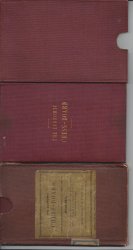
[The first English travelling chess set, invented by Peter Mark Roget; TWO from Family archive] The Roget family copies of ‘The Economic Chess-Board, Being a Chess-Board provided with a complete set of Chess-Men,’
See his entry in the Oxford DNB, and the biography by Joshua Kendall, ‘The Man Who Made Lists’ (2008). Roget’s travelling chess set was first marketed in April 1846 by De La Rue. Roget had parted company with the firm by October of the same year, moving to Longmans, while De La Rue continued to market their own rival version. Rarely found complete and undamaged. Chess-board One and Two are from the Roget family's own archive (more items from which are also offered for sale.) Chess-board One: The board and pieces are in good condition, with all present and everything in order; in worn and discoloured slipcase, with worn 8.5 x 7.5 cm white paper label on front. (All dimensions approximate.) A small label has been stuck across the spine of the slipcase, with the word ‘CHESS’ on it in ink. Board backing and case in plum waxed cloth. 19 x 15.5 cm when opened out, with one central horizontal fold halving the dimensions to 9.5 x 15.5 cm, and fitting into a slipcase of slightly larger dimensions, with label on front. The price at the head is worn: ‘Price [2]s. 6d.’. The text, within a decorative border, reads: ‘The Economic Chess-Board, Being a Chess-Board provided with a complete set of Chess-Men, Adapted for playing Games in Carriages or out of Doors, and for folding up and carrying in the Pocket, without disturbing the Game. Invented by P. M. Roget, M.D. And Registered according to Act of Parliament, November 10th 1845.’ London: Longmans,, Brown, Green, and Longmans. Once opened out, the board proper, which is in black and white and 10.5 cm, is printed across two pieces of 8.5 x 13.5 cm paper, with red border and cream surrounds, pasted onto the sturdy backing. It is ingeniously pleated, with the 32 pieces (16 red and 16 blue) printed on paper strips, fitting into pockets at the sides of the board. Chess-board Two: This is in good condition but missing two pawns. It has no printed information about publication (pulisher, date etc). The casing is blank, and the chess set simply has the words THE ECONOMIC CHESS-BOARD on its reverse (SEE IMAGE). Just a wild theory, but could it be a trial board sent to P.M. Roget by the publishers?


